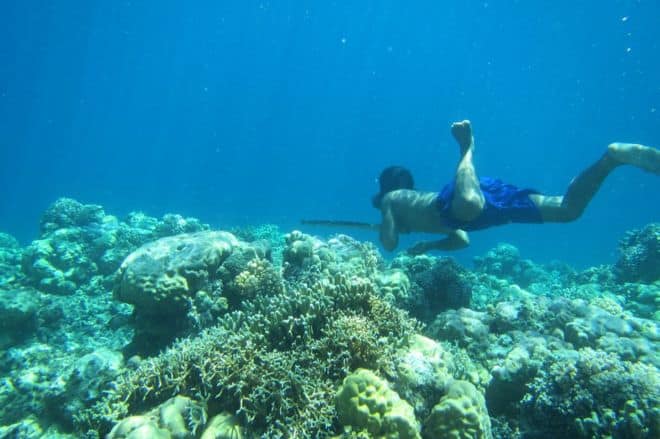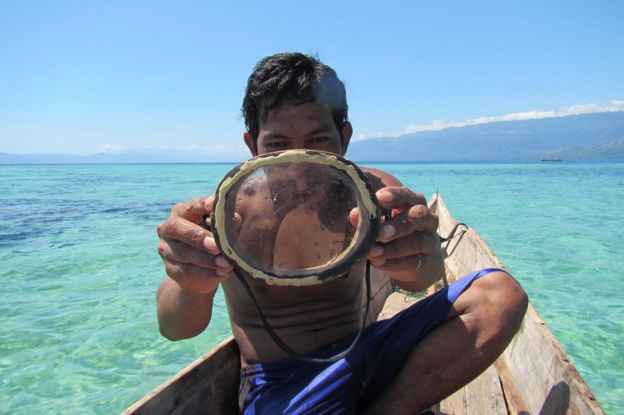
In a striking example of natural selection, the Bajau people of South-East Asia have developed bigger spleens for diving, a study shows.
The Bajau are traditionally nomadic and seafaring, and survive by collecting shellfish from the sea floor.
Scientists studying the effect of this lifestyle on their biology found their spleens were larger than those of related people from the region.
The bigger spleen makes more oxygen available in their blood for diving.
The researchers have published their results in the academic journal Cell.
Located close to the stomach, the fist-sized spleen removes old cells from the blood and acts as a biological “scuba tank” during long dives.
The Bajau people live across the southern Philippines, Indonesia and Malaysia and, according to rough estimates, number about one million people.

“For possibly thousands of years, [they] have been living on house boats, travelling from place to place in the waters of South-East Asia and visiting land only occasionally. So everything they need, they get from the sea,” first author Melissa Ilardo, from the University of Copenhagen, told the BBC’s Inside Science programme.
They were mentioned in writings from 1521 by the Venetian explorer Antonio Pigafetta, who was part of the first voyage to circumnavigate the globe. They are known for an extraordinary ability to hold their breath.
“When they’re diving in the traditional way, they dive repeatedly for about eight hours a day, spending about 60% of their time underwater. So this could be anything from 30 seconds to several minutes, but they’re diving to depths of over 70m,” said Dr Ilardo.
Astonishingly, these deep dives are performed only with a wooden mask or goggles and a weight belt. Dr Ilardo explained that the spleen was an obvious candidate for studying potential adaptations to this aquatic lifestyle.
“There’s a human dive response that’s triggered by holding your breath and submerging yourself in water. You can trigger it by submerging your face in cold water,” she explained.
“Your heart rate slows down, you have peripheral vasoconstriction where the blood vessels in your extremities get smaller to preserve the oxygenated blood for your vital organs and then the last thing is a contraction of the spleen.
“The spleen is a reservoir for oxygenated red blood cells, so when it contracts, it gives you an oxygen boost. It’s like a biological scuba tank.”
Dr Ilardo took a portable ultrasound machine to an area of Indonesia where the Bajau live. “I asked very nicely for the people to let me look at their spleens,” she said.
The results show that divers and non-divers from the Bajau community have similar sized spleens. This helped to show that the enlargement wasn’t simply a consequence of regular diving.
But when the researchers compared the Bajau to a neighbouring group called the Saluan, who traditionally lead a farming lifestyle, they found the Bajau had spleens that were 50% larger on average.
The team was also able to find an apparent genetic basis for the size difference. They compared the genomes (the total complement of DNA in the nuclei of human cells) of the Bajau, the Saluan and Han Chinese for areas that had been under natural selection.
“We could ask the question: are there any genetic variants – are there any mutations – that are at a much higher frequency, that have changed their frequency specifically in the Bajau compared to other populations,” said co-author Prof Rasmus Nielsen, from the University of California, Berkeley.
The results of this “selection scan” turned up 25 sites in the genome that differed significantly in the Bajau compared to the other groups. Of these, one site on a gene known as PDE10A was found to correlate with the Bajau’s larger spleen size, even after accounting for confounding factors like age, sex, and height.
In mice, PDE10A is known for regulating a thyroid hormone that controls spleen size, lending support for the idea that the Bajau might have evolved the spleen size necessary to sustain long, frequent dives.
In 2014, a different team published evidence for a genetic adaptation to living at high altitudes in Tibetan populations. In that case, the gene variant in question appeared to have originated in an ancient population known as the Denisovans, who appear to have been a “sister” population to the Neanderthals.
That gene variant was probably introduced into modern humans through ancient interbreeding (a process known as “introgression”), and then rose to high frequencies on the Tibetan plateau because of the advantage it conferred.
The team studying the Bajau also investigated whether something similar could have happened in this case, but found no evidence for such a link.
“It’s not clear how long the Bajau have had this lifestyle, or when exactly the adaptation arose give the genetic data that we have now,” said Dr Ilardo.
However, the data do show that the Bajau diverged from the non-diving Saluan around 15,000 years ago. According to Dr Ilardo, this was “plenty” of time to develop the aquatic adaptation.
Rasmus Nielsen added: “It’s a wonderful example of how humans can adapt to their local environments, but there may be some medical interest in this. There’s been a lot of interest in understanding hypoxia adaptations – adaptations to low oxygen levels.”
He said that, compared with the case of high altitude adaptations in Tibetans, the Bajau represented a potentially more medically relevant example: “This is acute low oxygen… if you look at trauma medicine, one of the most important factors is the response to low oxygen levels.
“By studying the Bajau, we can figure out: what are some of the genes that help predict differences in people in how they respond to acute low oxygen levels?”
